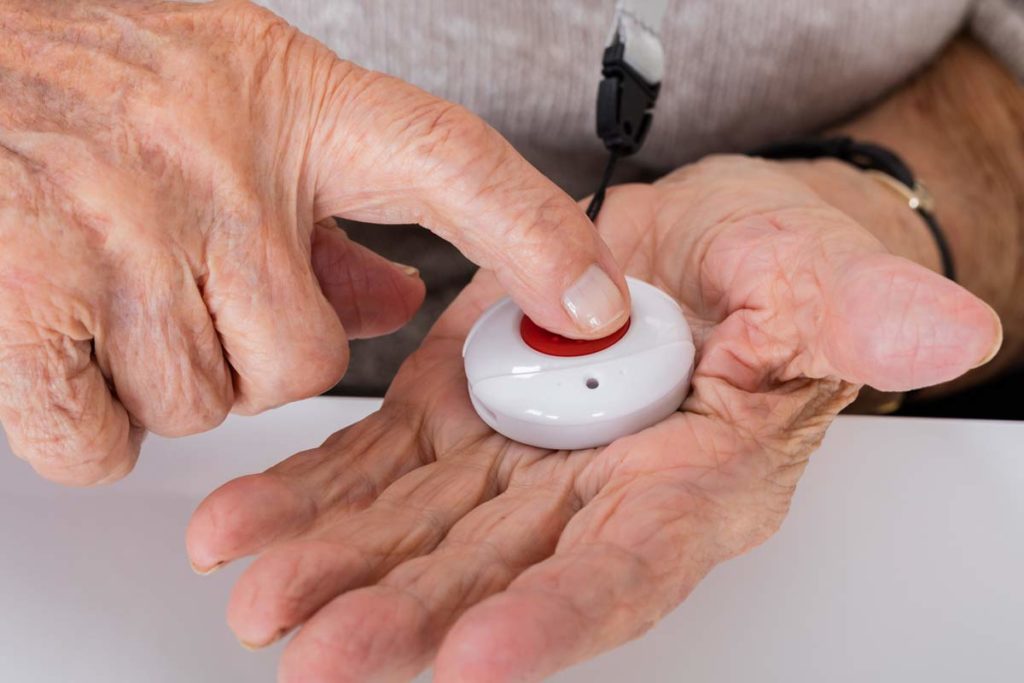When Can Emergency Buttons Be Used
There are many common emergencies that older adults might experience at home where an emergency button can be helpful and even life-saving:
- Falls and other accidents or injuries: According to the Centers for Disease Control and Prevention (CDC), one in four older adults falls each year, totaling approximately 36 million falls, and one in every five of these falls results in a significant injury.
- Chest pain: Chest pain is both uncomfortable and frightening, and it’s one of the most common complaints of older adults visiting hospital emergency departments. Chest pain isn’t always an emergency and can often be a symptom of long-term heart conditions, lung infections, pulled muscles, or even heartburn, but it can also be a key symptom of a heart attack.
- Stroke: The CDC reported that in the U.S., someone has a stroke every four seconds. Of those hospitalized for stroke, over 60% are over the age of 65.
- Respiratory distress: Older adults are at increased risk for lung infections like pneumonia and bronchitis, low oxygen levels, and abnormal breathing patterns, all of which can cause shortness of breath and respiratory distress emergencies.
- Home emergencies (gas leak, fire, no heat, plumbing flooding): These types of emergencies aren’t always what people think of when considering emergency buttons and medical alert systems, but these systems can contact the appropriate emergency response departments when and if they do occur. This is especially helpful for older adults who are physically impaired or have cognitive deficits. They may find it easier to press their emergency button instead of making a phone call.
An Emergency button is the easiest way to call for help.
An emergency button activates a call for help through a medical alert system with one push. Many (if not most) people know to call 911 or a similar number in the event of an emergency, and also may have friends or loved ones they know they can reach out to if they need help, but making an emergency call is sometimes easier said than done. If you’re experiencing a true emergency, it’s also likely that you could be in shock, in pain, cognitively impaired, or even have had a loss of consciousness. Particularly in the event of a fall, Steve Hruby, doctor of chiropractic, said: “There could be [pre-existing] cognitive impairments, making it harder for them to understand their surroundings and take care of themselves.” Pressing a single emergency button is the quickest and easiest way to call for help.
In the event of an emergency, response time matters.
One of the most beneficial features of an emergency button or medical alert system is how quickly an older adult can be connected with a call center and get emergency assistance. Most systems promise a response within seconds, and from there they determine the nature of your emergency and proceed to contact emergency services accordingly. Remember that the time it takes for local emergency response units to get to you will vary depending on your location. “This is an important conversation to have when considering a medical alert system, to set expectations and potentially build in other mechanisms to add to a feeling of security at home for older people,” said Christopher Norman, a board-certified geriatric nurse practitioner and holistic nurse.
Response time isn’t just important for the patient’s experience—it can also be the difference between life, permanent impairment, and death in some medical emergency cases. During a stroke, an average of 1.9 million brain cells die every minute, and fast treatment can reduce the risk of death by over 20%. In critical cases of chest pain, studies show that response time over 15 minutes can result in as little as a 5% chance of survival, versus a 33% chance of survival with response time under 15 minutes.
An emergency button offers peace of mind to you and your loved ones
Having an emergency button available can reduce the anxiety that many older adults have when living alone. Knowing that you can quickly and easily call for help can make aging in place feel more comfortable and practical—and empower you to go about your daily activities without feeling helpless or alone. Knowing that you have easy access to help if you can’t be reached can also help reduce caregiver stress.

What Emergency Button Options Are Available?
Medical alert systems with emergency buttons have options that work in your home, as well as cellular-connected systems you can wear for coverage on-the-go. Many systems even offer automatic fall detection.
Home units: Home-based systems usually include a base unit and a wearable emergency button and connect to the system’s call center through a landline or cellular service. You can call for help by pushing the button on the base unit or your wearable device, but you need to be within a certain distance from the base unit for the wearable button to work.
Mobile units: Mobile emergency buttons are designed to work away from home, are connected to the call center through cellular service, and often include GPS to pinpoint your location in the event of an emergency. These mobile emergency buttons are usually wearable devices in the form of a pendant, wristband, or clip-on button.
Fall detection systems: Many medical alert systems now offer automatic fall detection as an add-on or included feature. Emergency buttons are helpful if you’re able to press them, but a fall can often result in injury or loss of consciousness that could render you unable to press the button. Automatic fall detection is designed to sense a fall, and places a call automatically, ensuring that you are still connected to emergency assistance even when you can’t use your emergency button. It’s important to read reviews about other people’s experiences with fall detection on different devices. Every system is different, and some may be more sensitive than others. Norman noted that often, detection is dependent on the fall: “Falling from a standing position is often detected, whereas a slide out of a chair or off a bed is sometimes not,” he said.
Other Ways to Be Prepared or Prevent Emergencies at Home
At AgingInPlace.org we are big believers in the benefits of a medical alert system, but it’s also smart to take other steps to prepare for or prevent emergency situations.
Have a plan. Even if you plan to use an emergency button or medical alert system, designate a loved one to be the primary contact in case of emergencies. Let your family and friends know that they may someday be contacted if you need help so that they can also be prepared if the need ever arises.
Have a visiting consultation. Having a professional who is familiar with older adult care and fall prevention assess your home can help to identify hazards and adapt your daily routines to minimize fall risk. This professional could be a physical therapist, occupational therapist, nurse, or other visiting practitioner referred to you by your health care provider.
Remove potential hazards. Falls at home in older adulthood are incredibly common, but there are ways to reduce your risk of falling by removing hazards in your home. Adapt high thresholds, secure rug edges, install bathroom grab bars, and upgrade dim or inefficient lighting to help with navigation and stability.
Stay on top of your health and medical conditions. Being proactive about your health care helps you to know what your relative risk is for medical emergencies. Although some events can’t be predicted, knowing the status of your cardiovascular health can give you an idea of whether you’re at risk for medical emergencies like heart attack or stroke. Good nutrition promotes musculoskeletal strength and hydration can help to avoid dizziness and hypotension, all of which can reduce your risk of falling. Lastly, regularly checking in with your health care provider(s) regarding your medications can reduce unwanted interactions that could cause fall-risk symptoms like confusion, fatigue, and lightheadedness.
Bottom Line
At the end of the day, there’s no way to completely protect yourself from experiencing an emergency at home. Your risk of certain medical emergencies increases with age, and older adulthood can also bring physical limitations that prevent you from acting effectively and efficiently in the event of an emergency. Having an emergency button is an easy way to ensure you’ll be covered and have access to immediate help if you ever need it.
